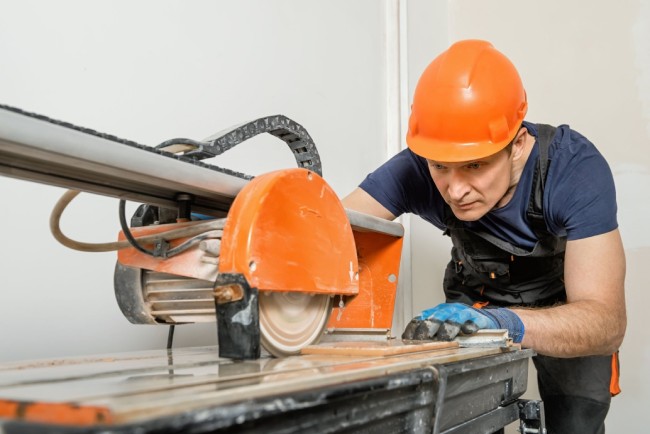Tile saws are convenient for industrial tasks. But like every other human-made device, it’s subject to occasional service even if you have the best tile saw. In this article, we are going to be talking about the blades, just like kitchen knives and every other sharp object.
The tile saw blade would need an occasional change after a while. The good news is changing the tile blade is a simple and easy task. But before you put on your tile-changing hats, you might want to be sure that the tile is in need of changing.
When to Replace Your Tile Saw Blade?

Here are some indications that the tile may need changing;
Tough cutting:
Tile wet saws are rigid devices with the capacity to effectively go through any material, with relative ease and steadiness. Once you notice that your operations are taking more time and the same materials that are easily cut through begin to build resistance, or you notice that you are beginning to exert more than usual pressure on the material, that might be a telltale sign that the blade needs changing.
Drifting:
A good wet saw draws lines with robotic precision. When the device is fresh and new, they are capable of cutting pieces of tile without any break or crack from the tile. When you notice that the wet saws tray is sliding precisely straight but the cuts are undesirable, this is a sign that the blade is twisted, bad, or is loose in such a way that it cannot be fastened.
Before changing the tile saw blades, you need to try to tighten the saw blades and test it. If the cuts are still undesirable, that is the green light to replace the tile saw blades.
Chirping
Stone, porcelain, and tiles are some of the materials that tile saws cut with precision and tenderness that a manual tile cutter cannot produce. The task ought to be comfortable and accurate with perfect edges. And no flying fragments which are likely to fly around when working with a dry blade.
When you notice chew-like or chipped cuts, and even tiny cracks when you are finished with the task, this flags that the blade used is dull. Tile wet saw blades are enveloped with tiny diamonds to get perfect cuts. But with extensive usage, over time, the diamonds pull off—and the result is a blunt blade.
You are changing material
You should not have problems cutting most material with the tile saw, some types of hard stone, porcelain, and glass tiles can need specific blades to do the cutting. Using the wrong type of blade can damage the tiles and at the same time damage the blades. Before you cut glass tiles, it is ideal for replacing the blades with a glass-cutting blade. This is applicable when using other materials.
Other signs
Include unusual vibration and visibly damaged blades. These indications are clear incentives for you to take the initiative. Changing the blades of the tile saw doesn’t take much time, and you can do it yourself without any hassle.
How to Change a Tile Saw Blade – Step By Step

Things you will need:
Since you are ready to change your tile saw blade, these are a list of things you will need available for your convenience;
- An adjustable wrench: to unscrew the nuts holding the blade in place.
- A screwdriver: depending on the make and the model, you might need to open a box concealing the blade.
- Safety: safety goggles and gloves to keep you safe while working.
Before we start, please do not forget to unplug the machine from the electric outlet if they were plugged in.
Steps
- Get to the saw blades: more than half of the tile saw blade is protected; typically, they come with a hinge that is releasable to expose the blade in time of replacement, while other models come with wing nuts, holding the cover in place. Remove the nut, open the cover, and get access to the blade.
- Use the adjustable wrench to loosen the nut (counterclockwise turn) in the middle of the cutting blade. Remove both the washer and the blade’s shaft.
- Detach the blade from its shaft. Do not forget to slide the blade towards you (carefully)
- Slide in the new blade carefully in the blade’s shaft, be sure of the direction you are installing it. Some cutting blades have to be attached with specific instructions. Search the blade for arrows and install the blade using the arrow as a guide.
- Install the locking nut. Put the locking nut and the washer back. Use the wrench again to tighten the nut–tight and secure.
- Reattach the cover; the cover was put there for safe usage, so you want to reattach it. Make sure that you tighten the nut. In instances where you are dealing with metal box cover, reattach it and screw with the head screw.
Tips
When screwing the nut in place, try to tighten it but do this excessively because you might want to replace the blade in the future. If the nut is overtightened, the job might be harder next time, and the machine can get damaged.
When releasing the nut, turn the wrench in a counterclockwise motion. Since some tabletop saws come with metal boxes beneath the saw blade, those also have to be removed. They are installed with lead screws that must be removed to detach the cover. Slide inward and then outward to get the box off. In cutting ceramic tiles, it is advisable that you go easy so as to avoid chipping.
Warnings
When handling power tools, it is imperative to put on safety equipment to protect your eyes, lungs, hands, and your body to avoid injury. The saws are very sharp and they require your attention when you are working with them. Don’t do this in places where children and pets can get to. Getting the nuts too tight makes later jobs tougher and ultimately damage the machine.
Conclusion
These are detailed guides to change your tile saw blade. So if you think your tile saw blade needs changing then get it done. This is an easy task and you can start using your tile saw in no time.
FAQs
Q. 1: Which way does a diamond blade go?
Ans: It is fully dependent on the model. To know the direction, you should see a comet tail following the exposed diamonds in cases where the blade is broken at the factory.
Q. 2: How long does a diamond blade last?
Ans: The diamond blades should last between 12 cutting hours to 120 cutting hours, depending on the quality of the machine and the blade.
Q. 3: How long should a wet saw blade last?
Ans: Depending on the quality of the blade, the blades should be able to last between 12 cutting hours to 120 cutting hours.
Q. 4: Can a diamond blade cut skin?
Ans: A diamond blade is a powerful tool that must be handled with caution. When working with a power tool, it is imperative to put on your safety gear to avoid any form of hazard. They do not cut skin but if you keep your fingers there for a while, they could cut or burn you.







